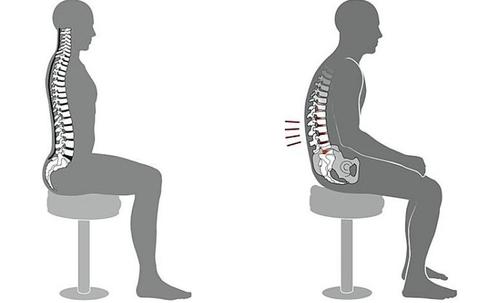In case you don’t know it, slouching is not ideal. In fact, not only does slouching make you look sloppy, it also results in pain for more than 80 percent of Americans.
Yet in today’s modern world, it’s easier than ever to find yourself sitting in a slouched position at your desk or slumped over a laptop for hours at a time. Slouching takes its toll on your muscles, joints, and ligaments, and causes changes in your spine’s natural curvature.
Over time it can even affect your circulation and digestion. And it almost always leads to pain after you’ve been slouching for too long.
We all fall into some unwanted habits when we sit for long periods of time. Fortunately, there are simple steps you can take to shift those habits and create a healthier setup for yourself when you sit so that you can stop slouching and enjoy some painless sitting!
Here I offer 5 simple steps you can put into practice right now to help you sit well and sustain it!
Step 1: Sit on Your Sit Bones!

It is vitally important that you sit directly on your sit bones, located directly at the bottom of your spine. This gives you the opportunity to lengthen up through your whole spine. If you sit behind them or round the lower back and don’t sit ON them, there is no way the rest of your body can fully lengthen up. After all, they’re called sit bones for a reason!
Step 2: Lengthen Your Spine

The second step is to lengthen your spine, but I know that sounds easier than it is to do sometimes. That’s why I created this little trick that I teach students:
- Take your hands and put the 4 fingers of each hand on the base of your skull. Put the thumb fingers under your jaw.
- Gently lift your skull up towards the ceiling while making sure to keep your face and eyes looking straight ahead. Hold this position for ten seconds.
That’s it — you’ve lengthened your spine! Now, release your hands, breathe deeply, soften your jaw, and practice staying in that length position while breathing and discovering or releasing any unnecessary tension.
Step 3: Use Support
Once you’ve take the first two steps, you will notice that your mid-to-upper back may feel tired or achy from the new work, as you will be using muscles you haven’t accessed for a while.
To ease that achiness, it is helpful to use some support behind your back so you can lean slightly into it while still lengthening your spine up. There are plenty of back support tools you can buy, but I find a rolled up towel works quite well!
Step 4: Create an Ergonomic Workspace

Let’s face it, you spend much of your sitting time in your workspace. The ergonomics of your workspace, therefore, deserves some attention.
Your screen should be at eye level in front of you. If your screen is too low, prop it up with a sturdy object, such as a monitor stand or a book.
When typing, your arms and wrists should be in a neutral position: parallel to the floor or angled down toward your lap to reduce strain.
If you use a laptop, there are a few additional considerations.
As useful as portable computers might be, their design has a critical flaw. Because the screen and the keyboard are so close together, using a laptop encourages a slumping posture, leaving your arms up too high, your neck craned forward, and your back slouching.
If you have the opportunity to do so, consider mounting your laptop on a laptop riser or on a stack of books, and then use an external keyboard and mouse. This will separate the keyboard and screen and allow you to get length in your spine as you work.
Step 5: Practice!
If you want to get better at something, it takes practice, practice, practice! Sitting properly is no different.
You will need patience to make these changes and the understanding that they will take time to have an effect — so get to practicing!
– – –
As I promised, these steps will take you from slouching and slouch-induced pain to hours of painless sitting. And, as I also promised, they are simple. Still, habits do not change overnight so you’ll need to be realistic about your timeline.
If you’ve had these poor postural habits for years, it will take some time to change them, but they WILL change with practice, focus, and commitment. So, be gentle with yourself and make today the day you start your no-slouching journey!
Image credits: Chris Curry and Heather Snyder Ippolito.
